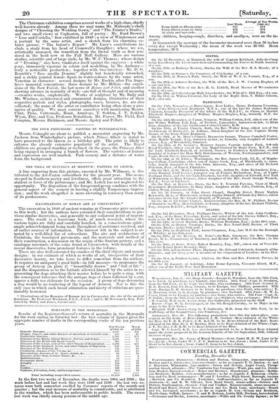ILLUSTRATIONS OF ROMAN ART AT CIRENCESTER.* The excavation in 1849
of ancient remains at Cirencester gave occasion to this work ; but the authors have extended their considerations to pre- vious similar discoveries, and generally to any collateral point of import- ance. The result is a handsome book, of much research, where the various topics are fully and carefully handled, in a conscientious spirit ; ample acknowledgment being made throughout of assistance received, and of earlier sources of information. The interest felt in the subject is at- tested by a well-filled list of subscribers. The site and architecture of Corinium, the tesselated pavements, and the materials and method of their construction, a discussion on the origin of the Samian pottery, and a catalogue raisonnee of the coins found at Cirencester, with details of the recent discoveries, form prominent features in the volume.
There are also well-executed fac-similes of the chief objects and mosaic designs : in our estimate of which as works of art, irrespective of their decorative beauty, we take leave to differ somewhat from the authors. It requires an antiquary's good faith—in full measure—to pronounce the group of Achron (in plate 2) "beautifully drawn" and "full of life " ; and the disquisition as to the latitude allowed himself by the artist in re presenting the dogs attacking their master before he is quite a stag, with the consequent inference that the antique dogs of chase followed by Kent, appear a trifle too elaborate for the occasion. A group of dogs devouring a stag would be no rendering of the legend of Actmon. Nor is this the only case in which such broad admiration and nicety of criticism are ques- tionably bestowed.
• Illustrations of the Remains of Roman Art in Cirencester, the site of the ancient Corinium. By Professor Buckman, F.L.S., F.G.S.; and C. H. Newmarch, Esq. Pub- lished by Bailey and Jones, Cirencester.






























 Previous page
Previous page